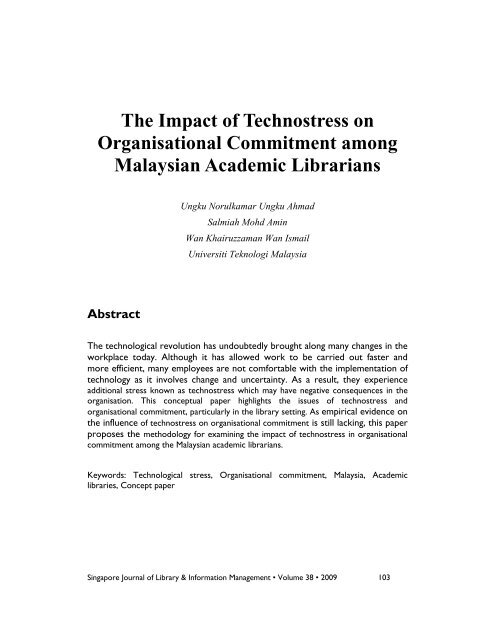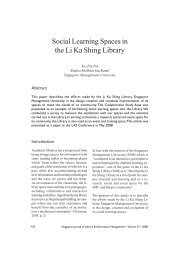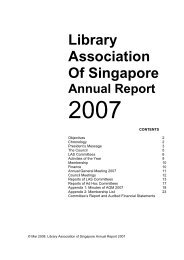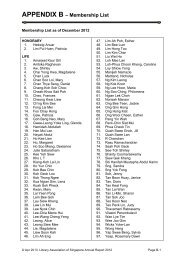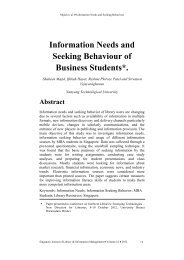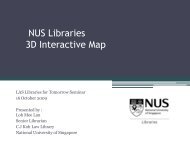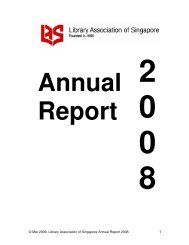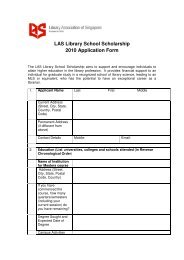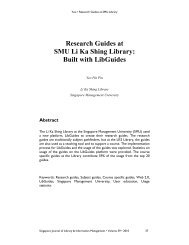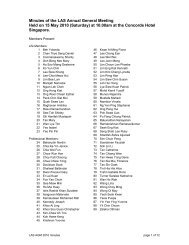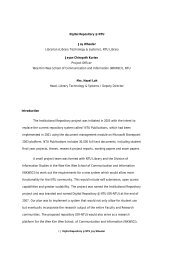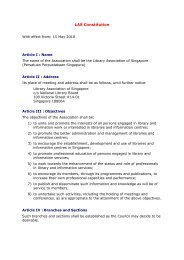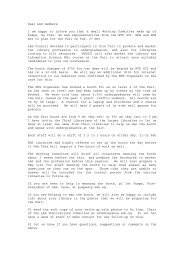The Impact of Technostress on Organisational Commitment among ...
The Impact of Technostress on Organisational Commitment among ...
The Impact of Technostress on Organisational Commitment among ...
You also want an ePaper? Increase the reach of your titles
YUMPU automatically turns print PDFs into web optimized ePapers that Google loves.
<str<strong>on</strong>g>The</str<strong>on</strong>g> <str<strong>on</strong>g>Impact</str<strong>on</strong>g> <str<strong>on</strong>g>of</str<strong>on</strong>g> <str<strong>on</strong>g>Technostress</str<strong>on</strong>g> <strong>on</strong>Organisati<strong>on</strong>al <strong>Commitment</strong> am<strong>on</strong>gMalaysian Academic LibrariansUngku Norulkamar Ungku AhmadSalmiah Mohd AminWan Khairuzzaman Wan IsmailUniversiti Teknologi MalaysiaAbstract<str<strong>on</strong>g>The</str<strong>on</strong>g> technological revoluti<strong>on</strong> has undoubtedly brought al<strong>on</strong>g many changes in theworkplace today. Although it has allowed work to be carried out faster andmore efficient, many employees are not comfortable with the implementati<strong>on</strong> <str<strong>on</strong>g>of</str<strong>on</strong>g>technology as it involves change and uncertainty. As a result, they experienceadditi<strong>on</strong>al stress known as technostress which may have negative c<strong>on</strong>sequences in theorganisati<strong>on</strong>. This c<strong>on</strong>ceptual paper highlights the issues <str<strong>on</strong>g>of</str<strong>on</strong>g> technostress andorganisati<strong>on</strong>al commitment, particularly in the library setting. As empirical evidence <strong>on</strong>the influence <str<strong>on</strong>g>of</str<strong>on</strong>g> technostress <strong>on</strong> organisati<strong>on</strong>al commitment is still lacking, this paperproposes the methodology for examining the impact <str<strong>on</strong>g>of</str<strong>on</strong>g> technostress in organisati<strong>on</strong>alcommitment am<strong>on</strong>g the Malaysian academic librarians.Keywords: Technological stress, Organisati<strong>on</strong>al commitment, Malaysia, Academiclibraries, C<strong>on</strong>cept paperSingapore Journal <str<strong>on</strong>g>of</str<strong>on</strong>g> Library & Informati<strong>on</strong> Management • Volume 38 • 2009 103
Ungku Norulkamar • <str<strong>on</strong>g>Impact</str<strong>on</strong>g> <str<strong>on</strong>g>of</str<strong>on</strong>g> <str<strong>on</strong>g>Technostress</str<strong>on</strong>g>Introducti<strong>on</strong>It is an undeniable fact that technology has become an integral part in today’ssociety. Technological revoluti<strong>on</strong> in organisati<strong>on</strong> has not <strong>on</strong>ly improvedefficiency but also helps reduce the problem <str<strong>on</strong>g>of</str<strong>on</strong>g> boredom in the workplace(Vieitez, Carcia, & Rodriquez, 2001). <str<strong>on</strong>g>The</str<strong>on</strong>g> advancement <str<strong>on</strong>g>of</str<strong>on</strong>g> technology has alsobeen a dominant force in improving and enhancing library services. <str<strong>on</strong>g>The</str<strong>on</strong>g>applicati<strong>on</strong> <str<strong>on</strong>g>of</str<strong>on</strong>g> library automati<strong>on</strong> has immensely improved the effectiveness <str<strong>on</strong>g>of</str<strong>on</strong>g>library activities such as acquisiti<strong>on</strong>, circulati<strong>on</strong>, cataloguing, reference, andserials c<strong>on</strong>trol (Bichteler, 1986; Murthy & Cholin, 2003). <str<strong>on</strong>g>The</str<strong>on</strong>g> ability <str<strong>on</strong>g>of</str<strong>on</strong>g> librariesto <str<strong>on</strong>g>of</str<strong>on</strong>g>fer access to digital informati<strong>on</strong> regardless <str<strong>on</strong>g>of</str<strong>on</strong>g> locati<strong>on</strong> and time has givenbirth to the term “virtual library”, “electr<strong>on</strong>ic library” or “digital library”(Gorman, 2001; Saunders, 1999).Nevertheless, as technology is rapidly changing, it has caused a lot <str<strong>on</strong>g>of</str<strong>on</strong>g> employeesto suffer from technostress. Previous literature indicated that <strong>on</strong>e attributi<strong>on</strong> <str<strong>on</strong>g>of</str<strong>on</strong>g>technological revoluti<strong>on</strong> in the workplace today was the rise <str<strong>on</strong>g>of</str<strong>on</strong>g> occupati<strong>on</strong>alstress (Gallie, 2005; Laff, 2006; Rosen & Weil, 2000). Basically, technostress isthe general feeling <str<strong>on</strong>g>of</str<strong>on</strong>g> anxiety and the negative impact <strong>on</strong> thoughts, behaviours,attitudes, and body when a pers<strong>on</strong> is expected to deal with technology(Kupersmith, 1992; Weil & Rosen, 1997). <str<strong>on</strong>g>The</str<strong>on</strong>g> usage <str<strong>on</strong>g>of</str<strong>on</strong>g> computer integratedsystem, CD-ROMs and multiple databases, the Internet and World Wide Web,and the rapid change <str<strong>on</strong>g>of</str<strong>on</strong>g> informati<strong>on</strong> technology has also caused an enormousamount <str<strong>on</strong>g>of</str<strong>on</strong>g> strain <strong>on</strong> librarians (Bichteler, 1987; Davis-Millis, 1998; Kupersmith,2006).Occupati<strong>on</strong>al stress, regardless <str<strong>on</strong>g>of</str<strong>on</strong>g> what causes it, has been found to have negativeinfluence <strong>on</strong> organisati<strong>on</strong>. For instance, higher levels <str<strong>on</strong>g>of</str<strong>on</strong>g> stress have beenassociated with lower organisati<strong>on</strong>al commitment (Ketchand & Strawser, 2001;Lopopolo, 2002). In the past, studies <strong>on</strong> technostress am<strong>on</strong>g the librarians havebeen mainly focused <strong>on</strong> the levels <str<strong>on</strong>g>of</str<strong>on</strong>g> technostress experienced, the sources <str<strong>on</strong>g>of</str<strong>on</strong>g>technostress, the symptoms <str<strong>on</strong>g>of</str<strong>on</strong>g> technostress, and the coping strategies used totackle the problem <str<strong>on</strong>g>of</str<strong>on</strong>g> technostress in the library (Bichteler, 1987; Champi<strong>on</strong>,1988; Harper, 2000; Kupersmith, 2006; Poole & Denny, 2001; Sami &Pangannaiah, 2006; Van Fleet & Wallace, 2003). Nevertheless, the repercussi<strong>on</strong>s<str<strong>on</strong>g>of</str<strong>on</strong>g> technostress <strong>on</strong> the librarians’ commitment towards their organisati<strong>on</strong>s remainSingapore Journal <str<strong>on</strong>g>of</str<strong>on</strong>g> Library & Informati<strong>on</strong> Management • Volume 38 • 2009 104
Ungku Norulkamar • <str<strong>on</strong>g>Impact</str<strong>on</strong>g> <str<strong>on</strong>g>of</str<strong>on</strong>g> <str<strong>on</strong>g>Technostress</str<strong>on</strong>g>to be investigated. Since the problem <str<strong>on</strong>g>of</str<strong>on</strong>g> technostress still persists in the librarysetting (Kupersmith, 2006; Nawe, 1995; Quinn, 2007; Sami & Pangannaiah,2006; Spacey, Goulding, & Murray, 2003; Van Fleet & Wallace, 2003), this studyintends to examine the impact <str<strong>on</strong>g>of</str<strong>on</strong>g> technostress <strong>on</strong> organisati<strong>on</strong>al commitmentam<strong>on</strong>g the librarians in the Malaysian public higher learning instituti<strong>on</strong>s. In orderto understand the phenomen<strong>on</strong> <str<strong>on</strong>g>of</str<strong>on</strong>g> technostress and its relati<strong>on</strong>ship withorganisati<strong>on</strong>al commitment, the issues <str<strong>on</strong>g>of</str<strong>on</strong>g> technostress and organisati<strong>on</strong>al commitmentparticularly in the library setting are highlighted. Towards the end <str<strong>on</strong>g>of</str<strong>on</strong>g> this paper, theproposed methodology for examining the impact <str<strong>on</strong>g>of</str<strong>on</strong>g> technostress in organisati<strong>on</strong>alcommitment am<strong>on</strong>g the Malaysian academic librarians is discussed.<str<strong>on</strong>g>Technostress</str<strong>on</strong>g><str<strong>on</strong>g>The</str<strong>on</strong>g> term technostress was coined in 1984 by a clinical psychologist, Dr. CraigBrod (1984, p. 16):<str<strong>on</strong>g>Technostress</str<strong>on</strong>g> is a modern disease <str<strong>on</strong>g>of</str<strong>on</strong>g> adaptati<strong>on</strong> caused by an inability to copewith the new computer technologies in a healthy manner. It manifests itself intwo distinct but related ways: in the struggle to accept computer technology, andin the more specialized form <str<strong>on</strong>g>of</str<strong>on</strong>g> overidentificati<strong>on</strong> with computer technology.Although Brod (1984) looked at technostress as a disease, other researchersc<strong>on</strong>sidered it more as an inability to adapt to changes brought by technology.Davis-Milis (1998) identified technostress as a c<strong>on</strong>diti<strong>on</strong> whereby a pers<strong>on</strong> has toadapt to new technology especially when there is inadequacy <str<strong>on</strong>g>of</str<strong>on</strong>g> the equipment,support, or the technology itself. Apart from that, according to Clark and Kalin(1996), the real definiti<strong>on</strong> <str<strong>on</strong>g>of</str<strong>on</strong>g> technostress is “resistance to change”. <str<strong>on</strong>g>The</str<strong>on</strong>g>y claimedthat technology is not the culprit because computer and technologies are just toolsand stress is a natural reacti<strong>on</strong>. Thus, they suggested that in order to managetechnostress, it is the change that has to be managed not the technology. <str<strong>on</strong>g>The</str<strong>on</strong>g>irview was supported by Champi<strong>on</strong> (1988) who stated that the informati<strong>on</strong> age wasall about change, or to be more specific, resp<strong>on</strong>se to “technochange”, not abouttechnical comp<strong>on</strong>ents such as machines, programs, network, or fibre optics.Singapore Journal <str<strong>on</strong>g>of</str<strong>on</strong>g> Library & Informati<strong>on</strong> Management • Volume 38 • 2009 105
Ungku Norulkamar • <str<strong>on</strong>g>Impact</str<strong>on</strong>g> <str<strong>on</strong>g>of</str<strong>on</strong>g> <str<strong>on</strong>g>Technostress</str<strong>on</strong>g>Tarafdar, Tu, Ragu-Nathan, and Ragu-Nathan (2007) described technostress as aproblem <str<strong>on</strong>g>of</str<strong>on</strong>g> adaptati<strong>on</strong> as a result <str<strong>on</strong>g>of</str<strong>on</strong>g> a pers<strong>on</strong>’s inability to cope with or to get usedto informati<strong>on</strong> and communicati<strong>on</strong> technologies (ICT). Additi<strong>on</strong>ally, they haveidentified five comp<strong>on</strong>ents <str<strong>on</strong>g>of</str<strong>on</strong>g> technostress, also known as technostress creators,which are:1. Techno-overload: A situati<strong>on</strong> where ICT users are forced to work faster andl<strong>on</strong>ger.2. Techno-invasi<strong>on</strong>: A situati<strong>on</strong> where ICT users felt that they can be reachedanytime or c<strong>on</strong>stantly “c<strong>on</strong>nected” which caused a blurring between workrelatedand pers<strong>on</strong>al c<strong>on</strong>texts.3. Techno-complexity: A situati<strong>on</strong> where ICT users feel that their skills areinadequate due to the complexity related to ICT. As a c<strong>on</strong>sequence, they areforced to spend time and effort to learn and understand the various aspects <str<strong>on</strong>g>of</str<strong>on</strong>g>ICT.4. Techno-insecurity: A situati<strong>on</strong> where ICT users feel threatened that they willlose their job, either being replaced by the new ICT or by other people whoare better in ICT compared to them.5. Techno-uncertainty: A situati<strong>on</strong> where ICT users feel uncertain and unsettledsince ICT is c<strong>on</strong>tinuously changing and need upgrading.Other terms that were syn<strong>on</strong>ymous with technostress used by other researchersinclude technophobia, computerphobia, computer anxiety, and computer stress(Chua, Chen, & W<strong>on</strong>g, 1999; Durndell & Haag, 2002; Mustaffa, Yus<str<strong>on</strong>g>of</str<strong>on</strong>g>, & Saad,2007). In additi<strong>on</strong>, the term digital depressi<strong>on</strong> has also been used to identify thefeeling <str<strong>on</strong>g>of</str<strong>on</strong>g> an employee when being overwhelmed by technology ("'Digitaldepressi<strong>on</strong>' identified as new form <str<strong>on</strong>g>of</str<strong>on</strong>g> stress", May 2003).<str<strong>on</strong>g>Technostress</str<strong>on</strong>g> in LibrariesSince the introducti<strong>on</strong> <str<strong>on</strong>g>of</str<strong>on</strong>g> the internet, librarians were am<strong>on</strong>g the early adopters ineducating users about the resources available <strong>on</strong> the internet. However, in theprocess <str<strong>on</strong>g>of</str<strong>on</strong>g> adapting to the increasingly complex technologies, more users and staffSingapore Journal <str<strong>on</strong>g>of</str<strong>on</strong>g> Library & Informati<strong>on</strong> Management • Volume 38 • 2009 106
Ungku Norulkamar • <str<strong>on</strong>g>Impact</str<strong>on</strong>g> <str<strong>on</strong>g>of</str<strong>on</strong>g> <str<strong>on</strong>g>Technostress</str<strong>on</strong>g>have been experiencing physical and emoti<strong>on</strong>al stress (Saunders, 1999) whichresulted in higher levels <str<strong>on</strong>g>of</str<strong>on</strong>g> absenteeism and turnover, higher cost for retrainingnew staff and increase in litigati<strong>on</strong> costs related to workplace stress (Harper,2000).In general, Bichteler (1986) found that librarians welcome technology in theirwork setting as it enhanced and improved their work. N<strong>on</strong>etheless, with theexistence <str<strong>on</strong>g>of</str<strong>on</strong>g> technology, users expected instant availability <str<strong>on</strong>g>of</str<strong>on</strong>g> documents; becamefrustrated with small collecti<strong>on</strong> in the library; insisted <strong>on</strong> computer search whenmanual search would be better; and became overwhelmed with informati<strong>on</strong> whensingle term search led to too many citati<strong>on</strong>s. Thus, dealing with these users hascaused the librarians to feel technostressed. In additi<strong>on</strong>, although the usage <str<strong>on</strong>g>of</str<strong>on</strong>g>word processing did help them work faster, it pushed them to produce more whilethe lead time is shortened. C<strong>on</strong>sequently, they felt it has caused excess work andput them under pressure to work faster.Bichteler (1986) also discovered that as a result <str<strong>on</strong>g>of</str<strong>on</strong>g> library automati<strong>on</strong> somelibrarians felt that their pers<strong>on</strong>alities had changed, in which they became morecomputer-oriented. <str<strong>on</strong>g>The</str<strong>on</strong>g>y were easily irritated and impatient when dealing withunorganised or illogical people and found it hard to communicate with n<strong>on</strong>programmers.<str<strong>on</strong>g>The</str<strong>on</strong>g> pressure to use the equipment efficiently and to stay <strong>on</strong>schedule had reduced their opportunities for c<strong>on</strong>versati<strong>on</strong> and led them to isolatethemselves from other people. Moreover, the librarians also felt frustrated whenthere is incompatibility between micros and mainframe, inaccessible andunhelpful sales representatives, lack <str<strong>on</strong>g>of</str<strong>on</strong>g> training, and inadequate time provided topractice what they have learned.<str<strong>on</strong>g>Technostress</str<strong>on</strong>g> in libraries were also found to stem out from organisati<strong>on</strong>al factor.For example, inadequate staff and insufficient number <str<strong>on</strong>g>of</str<strong>on</strong>g> printers, terminals, andwork stati<strong>on</strong>s which caused the librarians to share equipments was more likely tolead to frustrati<strong>on</strong> and avoidance (Kupersmith, 1992). Furthermore, inunsupportive climate where librarians perceived that their ideas were beingignored, their efforts going unnoticed, there were no rewards for pr<str<strong>on</strong>g>of</str<strong>on</strong>g>essi<strong>on</strong>aldevelopment, or when the organisati<strong>on</strong>s’ priorities were unclear, such factorswould c<strong>on</strong>tribute to librarians being much less able to deal with technology andits demands (Kupersmith, 1992).Singapore Journal <str<strong>on</strong>g>of</str<strong>on</strong>g> Library & Informati<strong>on</strong> Management • Volume 38 • 2009 107
Ungku Norulkamar • <str<strong>on</strong>g>Impact</str<strong>on</strong>g> <str<strong>on</strong>g>of</str<strong>on</strong>g> <str<strong>on</strong>g>Technostress</str<strong>on</strong>g>According to Harper (2000), there were two forms <str<strong>on</strong>g>of</str<strong>on</strong>g> technostress affectinglibrarians; the physical form and the psychological form. Complaints <str<strong>on</strong>g>of</str<strong>on</strong>g> headache,backstrain, eyestrain, repetitive strain injuries such as Carpal tunnel syndrome,and muscular dysfuncti<strong>on</strong>s were some <str<strong>on</strong>g>of</str<strong>on</strong>g> the physical forms <str<strong>on</strong>g>of</str<strong>on</strong>g> technostress. <str<strong>on</strong>g>The</str<strong>on</strong>g>psychological forms <str<strong>on</strong>g>of</str<strong>on</strong>g> technostress suffered by librarians included feelingdrained, informati<strong>on</strong> overload, overidentify with technology, underwork, anddoing routine jobs. In additi<strong>on</strong>, the fear that computers were taking over theirroles also led to feelings <str<strong>on</strong>g>of</str<strong>on</strong>g> job insecurity. <str<strong>on</strong>g>The</str<strong>on</strong>g>re were also feelings <str<strong>on</strong>g>of</str<strong>on</strong>g> jealousyam<strong>on</strong>g librarians when their levels <str<strong>on</strong>g>of</str<strong>on</strong>g> technology competencies differed andresulted in the loss <str<strong>on</strong>g>of</str<strong>on</strong>g> motivati<strong>on</strong> and team spirit. Spending so much time workingwith new technology also gave rise to feelings <str<strong>on</strong>g>of</str<strong>on</strong>g> job role uncertainty especiallywhen librarians find themselves doing the job <str<strong>on</strong>g>of</str<strong>on</strong>g> systems librarians.An <strong>on</strong>line survey by Kupersmith (2006) c<strong>on</strong>firmed that technostress existed in thelibrary setting. In fact, more than half <str<strong>on</strong>g>of</str<strong>on</strong>g> the librarian surveyed (59%) felt thatstress had increased in the past five years and almost two third <str<strong>on</strong>g>of</str<strong>on</strong>g> the resp<strong>on</strong>dentsbelieved that the problem was somewhat serious. It was also revealed by the studythat the leading causes <str<strong>on</strong>g>of</str<strong>on</strong>g> technostress in the library were informati<strong>on</strong> overload,networking problem, security issues and computer hardware, and erg<strong>on</strong>omics.Nevertheless, this finding somewhat c<strong>on</strong>tradicted with the findings <str<strong>on</strong>g>of</str<strong>on</strong>g> Poole andDenny (2001). A state-wide survey <str<strong>on</strong>g>of</str<strong>on</strong>g> community college library revealed that amajority <str<strong>on</strong>g>of</str<strong>on</strong>g> the librarians there felt that technology had neither increased nordecreased their amount <str<strong>on</strong>g>of</str<strong>on</strong>g> workplace stress. This may be due to the str<strong>on</strong>g statewidetraining available to the community college library pers<strong>on</strong>nel. A majority(82%) <str<strong>on</strong>g>of</str<strong>on</strong>g> the resp<strong>on</strong>dents agreed that the quality <str<strong>on</strong>g>of</str<strong>on</strong>g> the training provided wasmoderately good to excellent. This goes to show the importance <str<strong>on</strong>g>of</str<strong>on</strong>g> training inalleviating technostress.<str<strong>on</strong>g>The</str<strong>on</strong>g> development <str<strong>on</strong>g>of</str<strong>on</strong>g> internet and electr<strong>on</strong>ic networked resources encouraged thedevelopment <str<strong>on</strong>g>of</str<strong>on</strong>g> new services such as digital libraries. However, this might pose agreat challenge since the internet was also seen as a threat as it created a lot <str<strong>on</strong>g>of</str<strong>on</strong>g>uncertainty (Melchi<strong>on</strong>da, 2007). Although there would be some who wereoptimistic and proactive, there were others who feel threatened and resistant sincethey have no idea how to manage, work in, and survive in this new envir<strong>on</strong>ment.In additi<strong>on</strong>, the internet was also causing a sense <str<strong>on</strong>g>of</str<strong>on</strong>g> job insecurity. Somelibrarians feared that they would no l<strong>on</strong>ger be needed as library users would beable to use the internet without their help. Some librarians also felt threatened bySingapore Journal <str<strong>on</strong>g>of</str<strong>on</strong>g> Library & Informati<strong>on</strong> Management • Volume 38 • 2009 108
Ungku Norulkamar • <str<strong>on</strong>g>Impact</str<strong>on</strong>g> <str<strong>on</strong>g>of</str<strong>on</strong>g> <str<strong>on</strong>g>Technostress</str<strong>on</strong>g>those who were more flexible, smarter, and better trained in technologies. <str<strong>on</strong>g>The</str<strong>on</strong>g>transiti<strong>on</strong> from automati<strong>on</strong> to digitizati<strong>on</strong> meant that librarians had to acquirenew skills and competencies and be educated in new technologies, which in turnadded a further burden and stress to them (Melchi<strong>on</strong>da, 2007).Previous studies <strong>on</strong> technostress in libraries had been c<strong>on</strong>centrating <strong>on</strong> the sourcesand c<strong>on</strong>sequences <str<strong>on</strong>g>of</str<strong>on</strong>g> technostress. Studies <strong>on</strong> the correlati<strong>on</strong> <str<strong>on</strong>g>of</str<strong>on</strong>g> technostress in thelibrary setting with other aspects <str<strong>on</strong>g>of</str<strong>on</strong>g> organisati<strong>on</strong>al behaviour are still lacking.Al<strong>on</strong>gside knowing the source and the impact <str<strong>on</strong>g>of</str<strong>on</strong>g> technostress <strong>on</strong> employees, it isalso essential to investigate whether or not technostress affect other aspects <str<strong>on</strong>g>of</str<strong>on</strong>g>employee’s behaviour in the organisati<strong>on</strong>, such as organisati<strong>on</strong>al commitment.Organisati<strong>on</strong>al <strong>Commitment</strong>Committed employees can be described as those who have high involvement withtheir organisati<strong>on</strong>s and very much like to remain part <str<strong>on</strong>g>of</str<strong>on</strong>g> the organisati<strong>on</strong>s. Havingcommitted employees is advantageous to organisati<strong>on</strong> as they are less likely toresign or to be absent, and are more willing to share and make sacrifices for thesake <str<strong>on</strong>g>of</str<strong>on</strong>g> their organisati<strong>on</strong>s (Greenberg, 2005). In additi<strong>on</strong>, individuals whoexhibited higher commitment to their organisati<strong>on</strong>s were also found to havehigher loyalty and lower work stress (Muthuveloo & Rose, 2005), higherperformance (Bosh<str<strong>on</strong>g>of</str<strong>on</strong>g>f & Mels, 1994), and were much more willing to acceptorganisati<strong>on</strong>al change (Vakola & Nikolaou, 2005).Mowday, Steers, and Porter (1979) defined organisati<strong>on</strong>al commitment as theextent to which an employee identifed with and is involved in his particularorganisati<strong>on</strong>. This definiti<strong>on</strong> pointed out three basic comp<strong>on</strong>ents <str<strong>on</strong>g>of</str<strong>on</strong>g> organisati<strong>on</strong>alcommitment: (a) str<strong>on</strong>g belief and acceptance <str<strong>on</strong>g>of</str<strong>on</strong>g> the organisati<strong>on</strong>’s goals andvalues (identificati<strong>on</strong>), (b) willingness to exert a c<strong>on</strong>siderable amount <str<strong>on</strong>g>of</str<strong>on</strong>g> effort <strong>on</strong>behalf <str<strong>on</strong>g>of</str<strong>on</strong>g> the organisati<strong>on</strong> (involvement), and (c) str<strong>on</strong>g desire to remain in theorganisati<strong>on</strong> (loyalty).Singapore Journal <str<strong>on</strong>g>of</str<strong>on</strong>g> Library & Informati<strong>on</strong> Management • Volume 38 • 2009 109
Ungku Norulkamar • <str<strong>on</strong>g>Impact</str<strong>on</strong>g> <str<strong>on</strong>g>of</str<strong>on</strong>g> <str<strong>on</strong>g>Technostress</str<strong>on</strong>g>Organisati<strong>on</strong>al commitment is typically c<strong>on</strong>ceived as individual’s psychologicalb<strong>on</strong>d to the organisati<strong>on</strong> he is attached to (O'Reilly, 1989). This includes a sense<str<strong>on</strong>g>of</str<strong>on</strong>g> job involvement, loyalty, and belief in the values uphold by the organisati<strong>on</strong>.O’Reilly (1989) cited three stages <str<strong>on</strong>g>of</str<strong>on</strong>g> commitment. <str<strong>on</strong>g>The</str<strong>on</strong>g> first stage, known as thecompliance stage, is the lowest level <str<strong>on</strong>g>of</str<strong>on</strong>g> commitment whereby a pers<strong>on</strong> accepts theinfluence <str<strong>on</strong>g>of</str<strong>on</strong>g> others just because he wants to receive something in return, such aspay. <str<strong>on</strong>g>The</str<strong>on</strong>g> sec<strong>on</strong>d stage is the identificati<strong>on</strong> stage. In this stage, a pers<strong>on</strong> accepts theinfluence <str<strong>on</strong>g>of</str<strong>on</strong>g> others so as to maintain a satisfying relati<strong>on</strong>ship which in turn makeshim feel proud bel<strong>on</strong>ging to a certain organisati<strong>on</strong>. <str<strong>on</strong>g>The</str<strong>on</strong>g> highest level <str<strong>on</strong>g>of</str<strong>on</strong>g>commitment occurs in the last stage, the internalisati<strong>on</strong> stage, in which a pers<strong>on</strong>finds the values <str<strong>on</strong>g>of</str<strong>on</strong>g> the organisati<strong>on</strong> to be c<strong>on</strong>gruent with his pers<strong>on</strong>al values andintrinsically rewarding.According to Meyer and Allen (1991), organisati<strong>on</strong>al commitment is apsychological state which characterises the relati<strong>on</strong>ship <str<strong>on</strong>g>of</str<strong>on</strong>g> the employees to theorganisati<strong>on</strong> and has implicati<strong>on</strong>s <strong>on</strong> the employees’ decisi<strong>on</strong> to remain orc<strong>on</strong>tinue membership in the organisati<strong>on</strong>. <str<strong>on</strong>g>The</str<strong>on</strong>g>y further described three distinctforms <str<strong>on</strong>g>of</str<strong>on</strong>g> commitment which are:• Affective commitment which reflects the strength <str<strong>on</strong>g>of</str<strong>on</strong>g> the employees’ emoti<strong>on</strong>alattachment to, identificati<strong>on</strong> with, and involvement in the organisati<strong>on</strong>• C<strong>on</strong>tinuance commitment which can be described as the employees’ awareness<str<strong>on</strong>g>of</str<strong>on</strong>g> the cost <str<strong>on</strong>g>of</str<strong>on</strong>g> leaving the organisati<strong>on</strong>• Normative commitment which refers to the employees’ feeling <str<strong>on</strong>g>of</str<strong>on</strong>g> obligati<strong>on</strong> toremain in the organisati<strong>on</strong>In terms <str<strong>on</strong>g>of</str<strong>on</strong>g> organisati<strong>on</strong>al commitment am<strong>on</strong>g librarians, McCormick (2000)posited that librarians’ level <str<strong>on</strong>g>of</str<strong>on</strong>g> organisati<strong>on</strong>al commitment is significantlyinfluenced by career stages, type <str<strong>on</strong>g>of</str<strong>on</strong>g> library work setting, and number <str<strong>on</strong>g>of</str<strong>on</strong>g>dependents. Furthermore, more committed and satisfied librarians have beenfound in libraries that support participatory management, open communicati<strong>on</strong>,and opportunities for achievement (Burd, 2003). As far as the Malaysian setting isc<strong>on</strong>cerned, even though Karim and Noor (2006) claimed that Allen and Meyer’sOrganisati<strong>on</strong>al <strong>Commitment</strong> scale was applicable to Malaysian academiclibraries, the study did not discuss the level <str<strong>on</strong>g>of</str<strong>on</strong>g> organisati<strong>on</strong>al commitment <str<strong>on</strong>g>of</str<strong>on</strong>g> theselibrarians.Singapore Journal <str<strong>on</strong>g>of</str<strong>on</strong>g> Library & Informati<strong>on</strong> Management • Volume 38 • 2009 110
Ungku Norulkamar • <str<strong>on</strong>g>Impact</str<strong>on</strong>g> <str<strong>on</strong>g>of</str<strong>on</strong>g> <str<strong>on</strong>g>Technostress</str<strong>on</strong>g>C<strong>on</strong>sequences and Correlates <str<strong>on</strong>g>of</str<strong>on</strong>g> Organisati<strong>on</strong>al<strong>Commitment</strong>A more committed employee is said to be less likely to experience burnout(Freeborn, 1997). Previous empirical studies revealed that organisati<strong>on</strong>alcommitment would be able to predict employee’s absenteeism, performance,turnover, and other behaviours (Mathieu & Zajac, 1990). In additi<strong>on</strong>, the impact<str<strong>on</strong>g>of</str<strong>on</strong>g> organisati<strong>on</strong>al commitment was also found to be c<strong>on</strong>sistent in different parts <str<strong>on</strong>g>of</str<strong>on</strong>g>the world. For example, Siu (2003) c<strong>on</strong>firmed that organisati<strong>on</strong>al commitment ispositively related to job performance am<strong>on</strong>g employees in H<strong>on</strong>g K<strong>on</strong>g.It should be noted that different types <str<strong>on</strong>g>of</str<strong>on</strong>g> commitment would result in differentwork-related behaviour outcomes. For example, am<strong>on</strong>g the three Meyer and Allen(1991) comp<strong>on</strong>ents <str<strong>on</strong>g>of</str<strong>on</strong>g> commitment, affective commitment has generally beenfound to have more positive c<strong>on</strong>sequences for both the employees and theorganizati<strong>on</strong>. Affective commitment has been found to have a positiverelati<strong>on</strong>ship with job performance, though the relati<strong>on</strong>ship is weak (Allen &Meyer, 1996; Mathieu & Zajac, 1990). In additi<strong>on</strong>, it was also found to havenegative relati<strong>on</strong>ship, albeit weak, to absenteeism and lateness, but a str<strong>on</strong>gernegative relati<strong>on</strong>ship to turnover (Allen & Meyer, 1996; Mathieu & Zajac, 1990).Interestingly, even though all the three comp<strong>on</strong>ents <str<strong>on</strong>g>of</str<strong>on</strong>g> commitment werenegatively correlated with turnover, <strong>on</strong>ly affective commitment was found to benegatively related with absenteeism while normative and c<strong>on</strong>tinuancecommitment had a positive relati<strong>on</strong>ship with absenteeism. Furthermore, therelati<strong>on</strong>ship between c<strong>on</strong>tinuance commitment and desirable work behaviour wasalso inc<strong>on</strong>clusive, either unrelated or negatively related (Meyer, Stanley,Herscovitch, & Topolnytsky, 2002). Overall, these findings suggested thataffective commitment might provide better benefit to the organisati<strong>on</strong>.Numerous studies had also looked into the relati<strong>on</strong>ship <str<strong>on</strong>g>of</str<strong>on</strong>g> various variables withorganisati<strong>on</strong>al commitment. According to Ketchand and Strawser (2001),organisati<strong>on</strong>al commitment had been identified to have significant relati<strong>on</strong>shipswith job satisfacti<strong>on</strong>, job involvement, stress, occupati<strong>on</strong>al commitment, andmotivati<strong>on</strong>. Am<strong>on</strong>g these variables, past research had c<strong>on</strong>sistently proved thatSingapore Journal <str<strong>on</strong>g>of</str<strong>on</strong>g> Library & Informati<strong>on</strong> Management • Volume 38 • 2009 111
Ungku Norulkamar • <str<strong>on</strong>g>Impact</str<strong>on</strong>g> <str<strong>on</strong>g>of</str<strong>on</strong>g> <str<strong>on</strong>g>Technostress</str<strong>on</strong>g>there was a str<strong>on</strong>g positive relati<strong>on</strong>ship between organisati<strong>on</strong>al commitment andjob satisfacti<strong>on</strong> (Ketchand & Strawser, 2001; Le<strong>on</strong>g, Furnham, & Cooper, 1996;Mathieu & Zajac, 1990; Wu & Norman, 2006; Young, Worchel, & Woehr, 1998).Meyer, Stanley, Herscovitch, and Topolnytsky (2002) also argued that affectivecommitment had str<strong>on</strong>g correlati<strong>on</strong>s with job involvement, occupati<strong>on</strong>alcommitment, and had the str<strong>on</strong>gest correlati<strong>on</strong> with overall job satisfacti<strong>on</strong>.Moreover, the levels <str<strong>on</strong>g>of</str<strong>on</strong>g> commitment am<strong>on</strong>g the librarians had been found tosignificantly correlate with career development stage, types <str<strong>on</strong>g>of</str<strong>on</strong>g> library worksetting, and number <str<strong>on</strong>g>of</str<strong>on</strong>g> dependents (McCormick, 2000) and with their work values(Burd, 2003).A number <str<strong>on</strong>g>of</str<strong>on</strong>g> studies had also focussed specifically <strong>on</strong> the relati<strong>on</strong>ship betweenorganisati<strong>on</strong>al commitment and job stress (Bosh<str<strong>on</strong>g>of</str<strong>on</strong>g>f & Mels, 1994; Dale & Fox,2008; Lee & Jamil, 2003; Lopopolo, 2002; Mathieu & Zajac, 1990; Meyer,Stanley, Herscovitch, & Topolnytsky, 2002; Omolara, 2008; Tu, Ragu-Nathan, &Ragu-Nathan, 2001; Vakola & Nikolaou, 2005). According to Omolara (2008),employees with low level <str<strong>on</strong>g>of</str<strong>on</strong>g> stress were more committed to achievingorganisati<strong>on</strong>al goals and reported higher level <str<strong>on</strong>g>of</str<strong>on</strong>g> commitment towards theorganisati<strong>on</strong>. However, his study did not identify the specific stressors thatcorrelated with organisati<strong>on</strong>al behaviour, unlike the findings <str<strong>on</strong>g>of</str<strong>on</strong>g> Dale and Fox(2008), Tu, Ragu-Nathan and Ragu-Nathan (2001), Jamal (1990), Lopopolo(2002), Lee and Jamil (2003) and Bosh<str<strong>on</strong>g>of</str<strong>on</strong>g> and Mels (1994).<str<strong>on</strong>g>The</str<strong>on</strong>g> studies <str<strong>on</strong>g>of</str<strong>on</strong>g> Dale and Fox (2008), Lopopolo (2002), Tu, Ragu-Nathan andRagu-Nathan (2001), and Jamal (1990) all c<strong>on</strong>cluded that two type <str<strong>on</strong>g>of</str<strong>on</strong>g> rolestressors, namely role ambiguity and role c<strong>on</strong>flict, were negatively related toorganisati<strong>on</strong>al commitment. Focusing <strong>on</strong> role c<strong>on</strong>flict and role clarity, Lee andJamil (2003) also argued that role c<strong>on</strong>flict was negatively related to organisati<strong>on</strong>alcommitment while a positive relati<strong>on</strong>ship existed between role clarity andorganisati<strong>on</strong>al commitment. On the c<strong>on</strong>trary, Bosh<str<strong>on</strong>g>of</str<strong>on</strong>g>f and Mels (1994) <strong>on</strong>ly founda significant inverse relati<strong>on</strong>ship between organisati<strong>on</strong>al commitment and c<strong>on</strong>flictbut failed to find significant correlati<strong>on</strong> between organisati<strong>on</strong>al commitment androle ambiguity. While these studies were c<strong>on</strong>ducted across pr<str<strong>on</strong>g>of</str<strong>on</strong>g>essi<strong>on</strong>s andgeographical locati<strong>on</strong>s, they were still mainly limited to the stressors <str<strong>on</strong>g>of</str<strong>on</strong>g> rolec<strong>on</strong>flict and role ambiguity and did not focus <strong>on</strong> the different types <str<strong>on</strong>g>of</str<strong>on</strong>g>organisati<strong>on</strong>al commitment.Singapore Journal <str<strong>on</strong>g>of</str<strong>on</strong>g> Library & Informati<strong>on</strong> Management • Volume 38 • 2009 112
Ungku Norulkamar • <str<strong>on</strong>g>Impact</str<strong>on</strong>g> <str<strong>on</strong>g>of</str<strong>on</strong>g> <str<strong>on</strong>g>Technostress</str<strong>on</strong>g>As far as technostress is c<strong>on</strong>cerned, <strong>on</strong>ly <strong>on</strong>e recent study was found toinvestigate the influence <str<strong>on</strong>g>of</str<strong>on</strong>g> technostress <strong>on</strong> organisati<strong>on</strong>al commitment. In thisstudy which was c<strong>on</strong>ducted am<strong>on</strong>g the end users <str<strong>on</strong>g>of</str<strong>on</strong>g> Informati<strong>on</strong> andCommunicati<strong>on</strong> Technologies (ICT), the existence <str<strong>on</strong>g>of</str<strong>on</strong>g> technostress creators werefound to lead to a decline in job satisfacti<strong>on</strong> which in turn led to a decrease inorganisati<strong>on</strong>al and c<strong>on</strong>tinuance commitment while technostress inhibitors led tothe opposite trend (Ragu-Nathan, Tarafdar, Ragu-Nathan, & Tu, 2008).Nevertheless, this study did not show a direct relati<strong>on</strong>ship between technostressand organisati<strong>on</strong>al commitment. Suffice to say that empirical evidence <strong>on</strong> thephenomen<strong>on</strong> <str<strong>on</strong>g>of</str<strong>on</strong>g> technostress and its influence <strong>on</strong> organisati<strong>on</strong>al commitment isstill lacking.Although the subject <str<strong>on</strong>g>of</str<strong>on</strong>g> organisati<strong>on</strong>al commitment has been studied for morethan 30 years (for example, the organisati<strong>on</strong>al commitment questi<strong>on</strong>naire (OCQ)was developed by Porter in the 1970s (Mowday, 1998)), the importance <str<strong>on</strong>g>of</str<strong>on</strong>g>understanding the c<strong>on</strong>cept <str<strong>on</strong>g>of</str<strong>on</strong>g> organisati<strong>on</strong>al commitment should not bedownplayed. With the rapid changes, especially the technological revoluti<strong>on</strong> thatis taking place in organisati<strong>on</strong>s today, there is a big possibility that organisati<strong>on</strong>alcommitment is influenced by factors that have yet to be uncovered.Hypotheses DevelopmentTechnology can create stress due to several factors. As a tool for efficiency andproductivity improvement, technology has the capability to increase the pace <str<strong>on</strong>g>of</str<strong>on</strong>g>work that allows employees to produce more in a shorter time. However,technology can also cause some employees to experience an increase in theirworkload and to feel pressured to work faster, a phenomen<strong>on</strong> known as technooverload(Bichteler, 1986; Ragu-Nathan, Tarafdar, Ragu-Nathan, & Tu, 2008). Inadditi<strong>on</strong>, the ability <str<strong>on</strong>g>of</str<strong>on</strong>g> technology to c<strong>on</strong>nect employees with their workanywhere and at anytime has resulted in techno-invasi<strong>on</strong> whereby employees feelthat their pers<strong>on</strong>al lives are being invaded by the technology (Ragu-Nathan,Tarafdar, Ragu-Nathan, & Tu, 2008). As a result, they feel that they have tosacrifice their pers<strong>on</strong>al and family time and spend more time <strong>on</strong> their work, evenoutside the <str<strong>on</strong>g>of</str<strong>on</strong>g>fice.Singapore Journal <str<strong>on</strong>g>of</str<strong>on</strong>g> Library & Informati<strong>on</strong> Management • Volume 38 • 2009 113
Ungku Norulkamar • <str<strong>on</strong>g>Impact</str<strong>on</strong>g> <str<strong>on</strong>g>of</str<strong>on</strong>g> <str<strong>on</strong>g>Technostress</str<strong>on</strong>g><str<strong>on</strong>g>The</str<strong>on</strong>g> implementati<strong>on</strong> <str<strong>on</strong>g>of</str<strong>on</strong>g> technology in the workplace has also created technoinsecurity,a feeling <str<strong>on</strong>g>of</str<strong>on</strong>g> job insecurity which has led to an increase in anxiety andstress (Melchi<strong>on</strong>da, 2007; Vieitez, Carcia, & Rodriguez, 2001). In additi<strong>on</strong>, therapid change in technology besides creating techno-uncertainty, also means thattechnology end-users always need to learn new things and upgrade their skills,which resulted in techno-complexity (Harper, 2000). According to Ragu-Nathan,Tarafdar, Ragu-Nathan, and Tu (2008) techno-overload, techno-invasi<strong>on</strong>, technoinsecurity,techno-complexity, and techno-uncertainty are am<strong>on</strong>g the sources <str<strong>on</strong>g>of</str<strong>on</strong>g>technostress, known as technostress creators. Since stress may inversely influencecommitment, it is hypothesised that:Ha: <str<strong>on</strong>g>The</str<strong>on</strong>g>re is a negative correlati<strong>on</strong> between technostress creators andorganisati<strong>on</strong>al commitmentMethodologyIn order to examine the impact <str<strong>on</strong>g>of</str<strong>on</strong>g> technostress in organisati<strong>on</strong>al commitment am<strong>on</strong>g theMalaysian academic librarians, this study will utilise the survey method. Level <str<strong>on</strong>g>of</str<strong>on</strong>g>technostress am<strong>on</strong>g the resp<strong>on</strong>dents will be measured using the <str<strong>on</strong>g>Technostress</str<strong>on</strong>g>Creators scale developed by Tarafdar, Tu, Ragu-Nathan and Ragu-Nathan (2007)which c<strong>on</strong>sists <str<strong>on</strong>g>of</str<strong>on</strong>g> five technostress creators:1. Techno-overload which deals mainly with how the technology used by theresp<strong>on</strong>dents cause them to work faster, change their work habits and increasetheir workload.2. Techno-invasi<strong>on</strong> which deals with how the technology used in their work hasencroached into their pers<strong>on</strong>al life.3. Techno-insecurity which deals with whether or not the resp<strong>on</strong>dents feel thetechnology used is a threat to their job security.4. Techno-uncertainty which deals with the c<strong>on</strong>stant changes in the technologyused.Singapore Journal <str<strong>on</strong>g>of</str<strong>on</strong>g> Library & Informati<strong>on</strong> Management • Volume 38 • 2009 114
Ungku Norulkamar • <str<strong>on</strong>g>Impact</str<strong>on</strong>g> <str<strong>on</strong>g>of</str<strong>on</strong>g> <str<strong>on</strong>g>Technostress</str<strong>on</strong>g>5. Techno-complexity which deals with the percepti<strong>on</strong> <str<strong>on</strong>g>of</str<strong>on</strong>g> the resp<strong>on</strong>dentstowards the complexity <str<strong>on</strong>g>of</str<strong>on</strong>g> the technology used and whether they feel that theirskills now are adequate or otherwise.Meyer’s and Allen’s (1997) Organisati<strong>on</strong>al <strong>Commitment</strong> scale will be employedin measuring the resp<strong>on</strong>dent’s level <str<strong>on</strong>g>of</str<strong>on</strong>g> organisati<strong>on</strong>al commitment. <str<strong>on</strong>g>The</str<strong>on</strong>g> scale willc<strong>on</strong>sist <str<strong>on</strong>g>of</str<strong>on</strong>g> items measuring:1. Affective commitment which deals with how attached the resp<strong>on</strong>dent is totheir organisati<strong>on</strong>.2. C<strong>on</strong>tinuance commitment which deals with the resp<strong>on</strong>dents believe <strong>on</strong> thecost <str<strong>on</strong>g>of</str<strong>on</strong>g> leaving their organisati<strong>on</strong>s now.3. Normative commitment which deals with the degree <str<strong>on</strong>g>of</str<strong>on</strong>g> obligati<strong>on</strong> theresp<strong>on</strong>dents feel to stay with in their organisati<strong>on</strong>s.Resp<strong>on</strong>dents for this study will c<strong>on</strong>sist <str<strong>on</strong>g>of</str<strong>on</strong>g> librarians from the public higherlearning instituti<strong>on</strong>s in Malaysia. Since these libraries are well equipped with thelatest technology to better serve their clients, it is assumed that the librarians inthese instituti<strong>on</strong>s are also experiencing some levels <str<strong>on</strong>g>of</str<strong>on</strong>g> technostress. In additi<strong>on</strong>,studies <strong>on</strong> technostress in Malaysia were found not <strong>on</strong>ly to be limited but havebeen c<strong>on</strong>ducted <strong>on</strong>ly <strong>on</strong> academicians and managers (Ibrahim, 2007; Mustaffa,2007).Currently, there are 20 public instituti<strong>on</strong>s <str<strong>on</strong>g>of</str<strong>on</strong>g> higher learning in Malaysia. For thepurpose <str<strong>on</strong>g>of</str<strong>on</strong>g> this study, cluster sampling will be employed whereby <strong>on</strong>ly libraries inthe public higher learning instituti<strong>on</strong>s that have been set up more than 10 yearswill be chosen. This is because they are more established and have higherinvolvement in library automati<strong>on</strong>. <str<strong>on</strong>g>The</str<strong>on</strong>g>se libraries are:1. Perpustakaan Sultanah Zanariah, Universiti Teknologi Malaysia2. Library <str<strong>on</strong>g>of</str<strong>on</strong>g> Internati<strong>on</strong>al Islamic University Malaysia3. Perpustakaan Hamzah Sendut, Universiti Sains Malaysia4. Perpustakaan Universiti Malaya5. Perpustakaan Sultanah Bahiyah, Universiti Utara Malaysia6. Perpustakaan Sultan Abdul Samad, Universiti Putra MalaysiaSingapore Journal <str<strong>on</strong>g>of</str<strong>on</strong>g> Library & Informati<strong>on</strong> Management • Volume 38 • 2009 115
Ungku Norulkamar • <str<strong>on</strong>g>Impact</str<strong>on</strong>g> <str<strong>on</strong>g>of</str<strong>on</strong>g> <str<strong>on</strong>g>Technostress</str<strong>on</strong>g>7. Perpustakaan UKM, Universiti Kebangsaan Malaysi8. Perpustakaan Universiti Teknologi MARA9. Perpustakaan Universiti Malaysia Sarawak10. Perpustakaan Universiti Malaysia SabahLibrarians in this study will be defined according to the librarian service schemeas classified by the Jabatan Perkhidmatan Awam Malaysia. Thus, librarypers<strong>on</strong>nel with Grade S41 to Grade S54 will be included in the sampling <str<strong>on</strong>g>of</str<strong>on</strong>g> thisstudy (Skim Perkhidmatan Pustakawan, 2006). A sampling frame will be obtainedfrom the libraries’ web page. Since the size <str<strong>on</strong>g>of</str<strong>on</strong>g> populati<strong>on</strong> differs from <strong>on</strong>e libraryto another, proporti<strong>on</strong>ate stratified random sampling will be used to ensure aproporti<strong>on</strong>al representati<strong>on</strong> <str<strong>on</strong>g>of</str<strong>on</strong>g> every organisati<strong>on</strong>.<str<strong>on</strong>g>The</str<strong>on</strong>g> hypothesis will be tested using multiple regressi<strong>on</strong> analysis as it will involvemultivariate analysis (Hair, Anders<strong>on</strong>, Tatham, & Black, 1998; Punch, 2005).Specifically, stepwise regressi<strong>on</strong> approach will be utilised. By utilising multipleregressi<strong>on</strong>s analysis, the overall predictive power <str<strong>on</strong>g>of</str<strong>on</strong>g> the independent variables canbe maximised. In additi<strong>on</strong>, the predictive power <str<strong>on</strong>g>of</str<strong>on</strong>g> each independent variable tothe variate can be ascertained. Hence, for this study, the regressi<strong>on</strong> model will be:OC = a + b 1 TO + b 2 TIV + b 3 TU + b 4 TC + b 5 TIS + eWhere:OC = Organisati<strong>on</strong>al <strong>Commitment</strong>TO = Techno-overloadTIV = Techno-invasi<strong>on</strong>TU = Techno-uncertaintyTC = Techno-complexityTIS = Techno-insecuritySingapore Journal <str<strong>on</strong>g>of</str<strong>on</strong>g> Library & Informati<strong>on</strong> Management • Volume 38 • 2009 116
Ungku Norulkamar • <str<strong>on</strong>g>Impact</str<strong>on</strong>g> <str<strong>on</strong>g>of</str<strong>on</strong>g> <str<strong>on</strong>g>Technostress</str<strong>on</strong>g>C<strong>on</strong>clusi<strong>on</strong>Previous findings have shown that am<strong>on</strong>g the major causes <str<strong>on</strong>g>of</str<strong>on</strong>g> workplace stress intoday’s envir<strong>on</strong>ment is the introducti<strong>on</strong> and implementati<strong>on</strong> <str<strong>on</strong>g>of</str<strong>on</strong>g> technology. Sinceworkplace stress has normally resulted in negative c<strong>on</strong>sequences to individualsand organisati<strong>on</strong>s, an investigati<strong>on</strong> <strong>on</strong> the influence <str<strong>on</strong>g>of</str<strong>on</strong>g> technostress <strong>on</strong>organisati<strong>on</strong>al commitment is fundamental. Am<strong>on</strong>g those who have been heavilyaffected by technostress are librarians. Thus, this paper proposes a study <strong>on</strong> theimpact <str<strong>on</strong>g>of</str<strong>on</strong>g> technotress <strong>on</strong> organisati<strong>on</strong>al commitment am<strong>on</strong>g librarians working inthe libraries <str<strong>on</strong>g>of</str<strong>on</strong>g> Malaysian public higher learning instituti<strong>on</strong>s. <str<strong>on</strong>g>The</str<strong>on</strong>g> findings <str<strong>on</strong>g>of</str<strong>on</strong>g> thisstudy will generate new knowledge and provide fresh insights that may be fruitfulto organisati<strong>on</strong>s in dealing with the problem <str<strong>on</strong>g>of</str<strong>on</strong>g> technostress. Knowing howtechnostress affect librarians will enable public higher learning instituti<strong>on</strong>slibraries to plan appropriate mechanisms in managing stress due to technologyand maintain a high level <str<strong>on</strong>g>of</str<strong>on</strong>g> organisati<strong>on</strong>al commitment am<strong>on</strong>g the librarians.ReferencesAllen, N. J., & Meyer, J. P. (1996). Affective, c<strong>on</strong>tinuance, and normativecommitment to the organizati<strong>on</strong>: An examinati<strong>on</strong> <str<strong>on</strong>g>of</str<strong>on</strong>g> c<strong>on</strong>struct validity.Journal <str<strong>on</strong>g>of</str<strong>on</strong>g> Vocati<strong>on</strong>al Behavior, 49, 252-276.Bichteler, J. (1986). Human aspects <str<strong>on</strong>g>of</str<strong>on</strong>g> high tech in special libraries. SpecialLibraries Associati<strong>on</strong>, 77 (3), 121-128.Bichteler, J. (1987). <str<strong>on</strong>g>Technostress</str<strong>on</strong>g> in libraries: Causes, effects and soluti<strong>on</strong>s.Electr<strong>on</strong>ic Library, 5 (5), 282-287.Bosh<str<strong>on</strong>g>of</str<strong>on</strong>g>f, C., & Mels, G. (1994). A Causal model to evaluate the relati<strong>on</strong>shipsam<strong>on</strong>g supervisi<strong>on</strong>, role stress, organizati<strong>on</strong>al commitment and internalservice quality. European Journal <str<strong>on</strong>g>of</str<strong>on</strong>g> Marketing, 29 (2), 23-42.Brod, C. (1984). <str<strong>on</strong>g>Technostress</str<strong>on</strong>g>: <str<strong>on</strong>g>The</str<strong>on</strong>g> human cost <str<strong>on</strong>g>of</str<strong>on</strong>g> the computer revoluti<strong>on</strong>.Reading: Addis<strong>on</strong>-Wesley.Burd, B. (2003). Work values <str<strong>on</strong>g>of</str<strong>on</strong>g> academic librarians: Exploring the relati<strong>on</strong>shipsbetween values, job satisfacti<strong>on</strong>, commitment and intent to leave. PaperSingapore Journal <str<strong>on</strong>g>of</str<strong>on</strong>g> Library & Informati<strong>on</strong> Management • Volume 38 • 2009 117
Ungku Norulkamar • <str<strong>on</strong>g>Impact</str<strong>on</strong>g> <str<strong>on</strong>g>of</str<strong>on</strong>g> <str<strong>on</strong>g>Technostress</str<strong>on</strong>g>presented at the ACRL Eleventh Nati<strong>on</strong>al C<strong>on</strong>ference, 10-13 April,Charlotte, NC. Retrieved from http://www.ala.org/ala/mgrps/divs/acrl/events/pdf/burd.PDFChampi<strong>on</strong>, S. (1988, November). <str<strong>on</strong>g>Technostress</str<strong>on</strong>g>: Technology's toll. School LibraryJournal, 48-51.Chua, S. L., Chen, D. T., & W<strong>on</strong>g, A. F. L. (1999). Computer anxiety and itscorrelates: A Meta-analysis. Computers in Human Behavior, 15 (5), 609-623.Clark, K., & Kalin, S. (1996, August). <str<strong>on</strong>g>Technostress</str<strong>on</strong>g>ed out? How to cope in thedigital age. Library Journal, 30-32.Dale, K., & Fox, M. L. (2008). Leadership style and organizati<strong>on</strong>al commitment:Mediating effect <str<strong>on</strong>g>of</str<strong>on</strong>g> role stress. Journal <str<strong>on</strong>g>of</str<strong>on</strong>g> Managerial Issues. Retrievedfrom http://www.accessmylibrary.com/coms2/summary_0286-34281367_ITMDavis-Millis, N. (1998). <str<strong>on</strong>g>Technostress</str<strong>on</strong>g> and the organizati<strong>on</strong>: A manager's guide tosurvival in the informati<strong>on</strong> age. Paper presented at the 67th AnnualMeeting <str<strong>on</strong>g>of</str<strong>on</strong>g> the Music Library Associati<strong>on</strong>, 14 February, Bost<strong>on</strong>,Massachusetts. Retrieved from http://web.mit.edu/ninadm/www/mla.htm'Digital depressi<strong>on</strong>' identified as new form <str<strong>on</strong>g>of</str<strong>on</strong>g> stress. (2003, May). ManagementServices, Retrieved fromhttp://findarticles.com/p/articles/mi_qa5428/is_200305/ai_n21331012Durndell, A., & Haag, Z. (2002). Computer self-efficacy, computer anxiety,attitudes towards the Internet and reported experience with the Internet, bygender, in an East European sample. Computers in Human Behavior, 18,521-535.Gallie, D. (2005). Work pressure in Europe 1996-2001: Trends and determinants.British Journal <str<strong>on</strong>g>of</str<strong>on</strong>g> Industrial Relati<strong>on</strong>s, 43 (3), 351-375.Gorman, M. (2001). <str<strong>on</strong>g>Technostress</str<strong>on</strong>g> and library values. Library Journal, 124 (7),48-50.Greenberg, J. (2005). Managing behavior in organizati<strong>on</strong>s, 4th ed. Upper SaddleRiver, NJ: Pears<strong>on</strong>.Hair, J. F., Anders<strong>on</strong>, R. E., Tatham, R. L., & Black, W. C. (1998). Multivariatedata analysis, 5th ed. New Jersey: Prentice Hall.Singapore Journal <str<strong>on</strong>g>of</str<strong>on</strong>g> Library & Informati<strong>on</strong> Management • Volume 38 • 2009 118
Ungku Norulkamar • <str<strong>on</strong>g>Impact</str<strong>on</strong>g> <str<strong>on</strong>g>of</str<strong>on</strong>g> <str<strong>on</strong>g>Technostress</str<strong>on</strong>g>Harper, S. (2000). Managing technostress in UK Libraries: A realistic guide.Ariadne. Retrieved January 25, 2008 fromhttp://www.ariadne.ac.uk/issue25/technostress/intro.html.Ibrahim, R. Z. A. R., Bakar, A. A. & Nor, S. B. M. (2007). Techno stress: A studyam<strong>on</strong>g academic and n<strong>on</strong>-academic staff. In Dain<str<strong>on</strong>g>of</str<strong>on</strong>g>f, M. J. (Ed.)Erg<strong>on</strong>omics and health aspect <str<strong>on</strong>g>of</str<strong>on</strong>g> work with computers. Berlin: Springer.Jamal, M. (1990). Relati<strong>on</strong>ship <str<strong>on</strong>g>of</str<strong>on</strong>g> job stress and Type-A behavior to employees'job satisfacti<strong>on</strong>, organizati<strong>on</strong>al commitment, psychosomatic healthproblems, and turnover motivati<strong>on</strong>. Human Relati<strong>on</strong>s, 43 (8), 727-738.Karim, N. H. A., & Noor, N. H. N. M. (2006). Evaluating the psychometricproperties <str<strong>on</strong>g>of</str<strong>on</strong>g> Allen and Meyer's Organizati<strong>on</strong>al <strong>Commitment</strong> Scale: Across culture applicati<strong>on</strong> am<strong>on</strong>g Malaysian academic librarians. MalaysianJournal <str<strong>on</strong>g>of</str<strong>on</strong>g> Library & Informati<strong>on</strong> Science, 11 (1), 89-101.Ketchand, A., & Strawser, J. R. (2001). Multiple dimensi<strong>on</strong>s <str<strong>on</strong>g>of</str<strong>on</strong>g> organizati<strong>on</strong>alcommitment: Implicati<strong>on</strong>s for future accounting research. BehavioralReseach in Accounting. Retrieved October 7, 2008 fromhttp://www.accessmylibrary.com/coms2/summary_0286-10651365_ITMKupersmith, J. (1992). <str<strong>on</strong>g>Technostress</str<strong>on</strong>g> and the reference librarian. ReferenceServices Review, 20, 7-14.Kupersmith, J. (2006). Library technostress survey result. Retrieved October 7,2008 from http://www.jkup.net/tstress-survey-2003.htmlLaff, M. (2006). Got stress? T+D, 60 (7), 31-36.Lee, B. H., & Jamil, M. (2003). An empirical study <str<strong>on</strong>g>of</str<strong>on</strong>g> organizati<strong>on</strong>alcommitment: A multi-level approach. Journal <str<strong>on</strong>g>of</str<strong>on</strong>g> Behavioral and AppliedManagement, 4 (3), 176-189.Le<strong>on</strong>g, C. S., Furnham, A., & Cooper, C. L. (1996). <str<strong>on</strong>g>The</str<strong>on</strong>g> moderating effect <str<strong>on</strong>g>of</str<strong>on</strong>g>organizati<strong>on</strong>al commitment <strong>on</strong> the occupati<strong>on</strong>al stress outcomerelati<strong>on</strong>ship. Human Relati<strong>on</strong>s, 49 (10), 1345-1363.Lopopolo, R. B. (2002). <str<strong>on</strong>g>The</str<strong>on</strong>g> relati<strong>on</strong>ship <str<strong>on</strong>g>of</str<strong>on</strong>g> role-related variables <str<strong>on</strong>g>of</str<strong>on</strong>g> jobsatisfacti<strong>on</strong> and commitment to the organizati<strong>on</strong> in a restructured hospitalenvir<strong>on</strong>ment. Physical <str<strong>on</strong>g>The</str<strong>on</strong>g>rapy, 82 (10), 984-999.Mathieu, J. E., & Zajac, D. M. (1990). A review and meta-analysis <str<strong>on</strong>g>of</str<strong>on</strong>g> theantecedents, correlates, and c<strong>on</strong>sequences <str<strong>on</strong>g>of</str<strong>on</strong>g> organizati<strong>on</strong>al commitment.Psychological Bulletin, 108 (2), 171-194.Singapore Journal <str<strong>on</strong>g>of</str<strong>on</strong>g> Library & Informati<strong>on</strong> Management • Volume 38 • 2009 119
Ungku Norulkamar • <str<strong>on</strong>g>Impact</str<strong>on</strong>g> <str<strong>on</strong>g>of</str<strong>on</strong>g> <str<strong>on</strong>g>Technostress</str<strong>on</strong>g>McCormick, C. (2000). A study <str<strong>on</strong>g>of</str<strong>on</strong>g> the job attitudes (Job satisfacti<strong>on</strong>,organizati<strong>on</strong>al commitment, and career commitment) and careeradaptability <str<strong>on</strong>g>of</str<strong>on</strong>g> the members <str<strong>on</strong>g>of</str<strong>on</strong>g> the library and informati<strong>on</strong> sciencepr<str<strong>on</strong>g>of</str<strong>on</strong>g>essi<strong>on</strong>. Retrieved August 13, 2008, fromhttp://www.vla.org/Programs/MLAVLAsummary.htmMelchi<strong>on</strong>da, M. G. (2007). Librarians in the age <str<strong>on</strong>g>of</str<strong>on</strong>g> the Internet: <str<strong>on</strong>g>The</str<strong>on</strong>g>ir attitudesand roles. New Library World, 108 (3/4), 123-140.Meyer, J. P., & Allen, N. J. (1991). A Three-comp<strong>on</strong>ent c<strong>on</strong>ceptualizati<strong>on</strong> <str<strong>on</strong>g>of</str<strong>on</strong>g>organizati<strong>on</strong>al commitment. Human Resource Management Review, 1, 61-89.Meyer, J. P., & Allen, N. J. (1997). <strong>Commitment</strong> in the workplace: <str<strong>on</strong>g>The</str<strong>on</strong>g>ory,research and applicati<strong>on</strong>. Thousand Oaks, CA: Sage.Meyer, J. P., Stanley, D. J., Herscovitch, L., & Topolnytsky, L. (2002). Affective,c<strong>on</strong>tinuance, and normative commitment to the organizati<strong>on</strong>: A Metaanalysis<str<strong>on</strong>g>of</str<strong>on</strong>g> antecedents, correlates, and c<strong>on</strong>sequences. Journal <str<strong>on</strong>g>of</str<strong>on</strong>g>Vocati<strong>on</strong>al Behavior, 61, 20-52.Mowday, R. T. (1998). Reflecti<strong>on</strong>s <strong>on</strong> the study and relevance <str<strong>on</strong>g>of</str<strong>on</strong>g> organizati<strong>on</strong>alcommitment. Human Resource Management Review, 8 (4), 387-401.Mowday, R. T., Steers, R. M., & Porter, L. W. (1979). <str<strong>on</strong>g>The</str<strong>on</strong>g> Measurement <str<strong>on</strong>g>of</str<strong>on</strong>g>organizati<strong>on</strong>al commitment. Journal <str<strong>on</strong>g>of</str<strong>on</strong>g> Vocati<strong>on</strong>al Behavior, 14 (2), 224-247.Murthy, T. A. V., & Cholin, V. S. (2003). Library automati<strong>on</strong>. RetrievedDecember 19, 2008, fromhttp://dspace.inflibnet.ac.in/bitstream/1994/170/3/03cali_1.pdfMustaffa, C. S., Yus<str<strong>on</strong>g>of</str<strong>on</strong>g>, R., & Saad, A. R. M. (2007). Technophobia andindividual characteristics: Understanding computer-related technostressam<strong>on</strong>g Malaysian employees. Paper presented at the 5th Internati<strong>on</strong>alC<strong>on</strong>ference <strong>on</strong> Communicati<strong>on</strong> and Mass Media, May 21-22, Athens,Greece.Muthuveloo, R., & Rose, R. C. (2005). Antecedents and outcomes <str<strong>on</strong>g>of</str<strong>on</strong>g>organisati<strong>on</strong>al commitment am<strong>on</strong>g Malaysian engineers. AmericanJournal <str<strong>on</strong>g>of</str<strong>on</strong>g> Applied Sciences, 2 (6), 1095 - 1100.Nawe, J. (1995). Work-related stress am<strong>on</strong>g the library and informati<strong>on</strong>workforce. Library Review, 44 (6), 30-37.Singapore Journal <str<strong>on</strong>g>of</str<strong>on</strong>g> Library & Informati<strong>on</strong> Management • Volume 38 • 2009 120
Ungku Norulkamar • <str<strong>on</strong>g>Impact</str<strong>on</strong>g> <str<strong>on</strong>g>of</str<strong>on</strong>g> <str<strong>on</strong>g>Technostress</str<strong>on</strong>g>O'Reilly, C. (1989). Corporati<strong>on</strong>s, culture and commitment: Motivati<strong>on</strong> and socialc<strong>on</strong>trol in organizati<strong>on</strong>s. California Management Review, 31 (4).Omolara, B. E. (2008). Influence <str<strong>on</strong>g>of</str<strong>on</strong>g> work related stress <strong>on</strong> organizati<strong>on</strong>alcommitment at Olabisi Onabanjo University Ago Iwoye Ogun StateNigeria. Paper presented at the 2008 EABR & TLC C<strong>on</strong>ferenceProceedings, Rothenburg, Germany.Poole, C. E., & Denny, E. (2001, November). Technological change in theworkplace: A statewide survey <str<strong>on</strong>g>of</str<strong>on</strong>g> community college library and learningresources pers<strong>on</strong>nel. College & Research Libraries, 503-515.Punch, K. F. (2005). Introducti<strong>on</strong> to social research: Quantitative and qualitativeapproaches, 2nd ed. L<strong>on</strong>d<strong>on</strong>: Sage.Quinn, B. A. (2007). Overcoming technostress in reference services to adultlearners. Libraries Faculty Research, Texas Tech University (eScholarshipRepository), 1-23. Retrieved from http://esr.li.ttu.edu/lib_fac_research/19Ragu-Nathan, T. S., Tarafdar, M., Ragu-Nathan, B. S., & Tu, Q. (2008). <str<strong>on</strong>g>The</str<strong>on</strong>g>c<strong>on</strong>sequences <str<strong>on</strong>g>of</str<strong>on</strong>g> technostress for end users in organizati<strong>on</strong>s: C<strong>on</strong>ceptualdevelopment and empirical validati<strong>on</strong>. Informati<strong>on</strong> Systems Research, 19(4), 417-433.Rosen, L. D., & Weil, M. M. (2000). Results <str<strong>on</strong>g>of</str<strong>on</strong>g> our 49-m<strong>on</strong>th study <str<strong>on</strong>g>of</str<strong>on</strong>g> businessattitudes show clerical/support staff, managers and executives using moretechnology at work and at home and becoming more hesitant toward newtechnology. Byte Back, LLC and Human-Ware, LLC, 1-16. Retrievedfrom http://www.technostress.com/busstudy2000.htmSami, L. K., & Pangannaiah, K. B. (2006). "<str<strong>on</strong>g>Technostress</str<strong>on</strong>g>": A Literature survey <strong>on</strong>the effect <str<strong>on</strong>g>of</str<strong>on</strong>g> informati<strong>on</strong> technology <strong>on</strong> library users. Library Review, 55,429-439. Retrieved from http://www.emeraldinsight.com/0024-2535.htmSaunders, L. M. (1999). <str<strong>on</strong>g>The</str<strong>on</strong>g> Human element in the virtual library. LibraryTrends, 47 (4), 771-789.Siu, O.L. (2003). Job stress and job performance am<strong>on</strong>g employees in H<strong>on</strong>gK<strong>on</strong>g: <str<strong>on</strong>g>The</str<strong>on</strong>g> role <str<strong>on</strong>g>of</str<strong>on</strong>g> Chinese work values and organizati<strong>on</strong>al commitment.Internati<strong>on</strong>al Journal <str<strong>on</strong>g>of</str<strong>on</strong>g> Psychology, 38 (6), 337-347.Skim Perkhidmatan Pustakawan. (2006). Retrieved fromhttp://www.jpa.gov.my/pekeliling/pp05/bil34/LampA1.pdfSingapore Journal <str<strong>on</strong>g>of</str<strong>on</strong>g> Library & Informati<strong>on</strong> Management • Volume 38 • 2009 121
Ungku Norulkamar • <str<strong>on</strong>g>Impact</str<strong>on</strong>g> <str<strong>on</strong>g>of</str<strong>on</strong>g> <str<strong>on</strong>g>Technostress</str<strong>on</strong>g>Spacey, R., Goulding, A., & Murray, I. (2003). ICT and change in UK publiclibraries: Does training matter? Library Management, 24, 61-69. Retrievedfrom http://www.emeraldinsight.com/0143-5124Tarafdar, M., Tu, Q., Ragu-Nathan, B. S., & Ragu-Nathan, T. S. (2007). <str<strong>on</strong>g>The</str<strong>on</strong>g>impact <str<strong>on</strong>g>of</str<strong>on</strong>g> technostress <strong>on</strong> role stress and productivity. Journal <str<strong>on</strong>g>of</str<strong>on</strong>g>Informati<strong>on</strong> Management Systems, 24, 1, 301-328. Retrieved fromhttp://www.jmis-web.org/articles/v24_n1_p301/index.htmlTu, Q., Ragu-Nathan, B., & Ragu-Nathan, T. S. (2001). A Path analytic study <str<strong>on</strong>g>of</str<strong>on</strong>g>the antecedents <str<strong>on</strong>g>of</str<strong>on</strong>g> organizati<strong>on</strong>al commitment <str<strong>on</strong>g>of</str<strong>on</strong>g> IS managers.Informati<strong>on</strong> Resources Management Journal, 14 (3), 27-36.Vakola, M., & Nikolaou, I. (2005). Attitudes towards organizati<strong>on</strong>al change:What is the role <str<strong>on</strong>g>of</str<strong>on</strong>g> employees' stress and commitment? EmployeeRelati<strong>on</strong>s, 27 (2), 160-174.Van Fleet, C., & Wallace, D. P. (2003). Virtual libraries - real threats:<str<strong>on</strong>g>Technostress</str<strong>on</strong>g> and virtual reference. Reference & User Services Quarterly,42 (3), 188-191.Vieitez, J. C., Carcia, A. D. L. T., & Rodriguez, M. T. V. (2001). Percepti<strong>on</strong> <str<strong>on</strong>g>of</str<strong>on</strong>g>job security in a process <str<strong>on</strong>g>of</str<strong>on</strong>g> technological change: Its influence <strong>on</strong>psychological well-being. Behaviour & Informati<strong>on</strong> Technology, 20 (3),213-223.Weil, M. M., & Rosen, L. D. (1997). <str<strong>on</strong>g>Technostress</str<strong>on</strong>g>: Coping with technology@Work @Home @Play: New York: Wiley.Wu, L., & Norman, I. J. (2006). An investigati<strong>on</strong> <str<strong>on</strong>g>of</str<strong>on</strong>g> job satisfacti<strong>on</strong>,organizati<strong>on</strong>al commitment and role c<strong>on</strong>flict and ambiguity in a sample <str<strong>on</strong>g>of</str<strong>on</strong>g>Chinese undergraduate nursing students. Nurse Educati<strong>on</strong> Today, 26, 304-314.Young, B. S., Worchel, S., & Woehr, D. J. (1998). Organizati<strong>on</strong>al commitmentam<strong>on</strong>g public service employees. Public Pers<strong>on</strong>nel Management, 27 (3),339-348.Singapore Journal <str<strong>on</strong>g>of</str<strong>on</strong>g> Library & Informati<strong>on</strong> Management • Volume 38 • 2009 122
Ungku Norulkamar • <str<strong>on</strong>g>Impact</str<strong>on</strong>g> <str<strong>on</strong>g>of</str<strong>on</strong>g> <str<strong>on</strong>g>Technostress</str<strong>on</strong>g>About the AuthorsUngku Norulkamar Ungku Ahmad, Senior Lecturer, Dept <str<strong>on</strong>g>of</str<strong>on</strong>g> Management,Faculty <str<strong>on</strong>g>of</str<strong>on</strong>g> Management and HRD, Universiti Teknologi Malaysia, MalaysiaEmail: ungkunor@yahoo.comSalmiah Mohd Amin, Head, Dept <str<strong>on</strong>g>of</str<strong>on</strong>g> Management, Faculty <str<strong>on</strong>g>of</str<strong>on</strong>g> Management andHRD, Universiti Teknologi Malaysia, MalaysiaEmail: salmiahamin@yahoo.comWan Khairuzzaman Wan Ismail, Associate Pr<str<strong>on</strong>g>of</str<strong>on</strong>g>essor, Internati<strong>on</strong>al BusinessSchool, UTM Internati<strong>on</strong>al Campus, MalaysiaEmail: m-wkhair@utm.mySingapore Journal <str<strong>on</strong>g>of</str<strong>on</strong>g> Library & Informati<strong>on</strong> Management • Volume 38 • 2009 123


